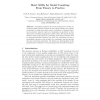Free Online Productivity Tools
i2Speak
i2Symbol
i2OCR
iTex2Img
iWeb2Print
iWeb2Shot
i2Type
iPdf2Split
iPdf2Merge
i2Bopomofo
i2Arabic
i2Style
i2Image
i2PDF
iLatex2Rtf
Sci2ools
SAT
2007
Springer
2007
Springer
Short XORs for Model Counting: From Theory to Practice
Abstract. A promising approach for model counting was recently introduced, which in theory requires the use of large random xor or parity constraints to obtain near-exact counts of solutions to Boolean formulas. In practice, however, short xor constraints are preferred as they allow better constraint propagation in SAT solvers. We narrow this gap between theory and practice by presenting experimental evidence that for structured problem domains, very short xor constraints can lead to probabilistic variance as low as large xor constraints, and thus provide the same correctness guarantees. We initiate an understanding of this phenomenon by relating it to structural properties of synthetic instances.
| Added | 09 Jun 2010 |
| Updated | 09 Jun 2010 |
| Type | Conference |
| Year | 2007 |
| Where | SAT |
| Authors | Carla P. Gomes, Jörg Hoffmann, Ashish Sabharwal, Bart Selman |
Comments (0)

